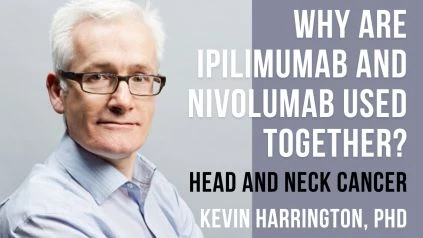Dr. Kevin Harrington, Phd of the Royal Marsden Hospital, The Institute of Cancer Research, London, is the author of this OncologyTube.com video.
August 5, 2023
Timestamps:
0:29 Why are ipilimumab and nivolumab used together?
0:39 What was the objective of the phase II CheckMate 714 trial?
1:40 How many patients were included in the trial, and what were the inclusion criteria?
3:23 What were the treatment regimens tested in the trial?
4:06 What were the primary endpoints of the trial?
5:33 Did the addition of ipilimumab to nivolumab improve the objective response rate in patients with recurrent or metastatic squamous cell carcinoma of the head and neck with platinum-refractory disease? What were the response rates in both groups?
8:48 What were the adverse events observed in both treatment groups, and how did they compare?
11:46 Did treatment-related adverse events lead to discontinuation of treatment, and if so, how often?
13:09 What were the conclusions drawn by the investigators based on the trial results?
14:08 What are the potential implications of these findings for the treatment of recurrent or metastatic head and neck cancer, and what future research is suggested by the results?
The phase II CheckMate 714 trial evaluated the efficacy and safety of combining the immune checkpoint inhibitors ipilimumab and nivolumab as first-line treatment for patients with recurrent or metastatic squamous cell carcinoma of the head and neck. The study, conducted by Kevin J. Harrington, MBBS, PhD, and colleagues, included 425 patients from 21 countries who had not received prior systemic therapy for their advanced disease.
Between October 2016 and January 2019, the participants were randomly assigned in a 2:1 ratio to receive either nivolumab at 3 mg/kg every 2 weeks plus ipilimumab at 1 mg/kg every 6 weeks or placebo. The treatment continued for up to 2 years, or until disease progression or unacceptable toxicity occurred. The primary endpoints of the study were the objective response rate and duration of response in the population with platinum-refractory recurrent or metastatic squamous cell carcinoma of the head and neck.
The results showed that the addition of ipilimumab to nivolumab did not improve the objective response rate as compared to nivolumab alone. Among the patients with platinum-refractory disease, the objective response rate was 13.2% in the combination group and 18.3% in the nivolumab group. Similarly, in the platinum-eligible population, the objective response rate was 20.3% with the combination and 29.5% with nivolumab alone. However, these differences were not statistically significant.
Furthermore, the median duration of response was not reached in the combination group for the platinum-refractory population, while it was 11.1 months in the nivolumab group. In the platinum-eligible population, the median duration of response was 27.0 months with the combination and 24.6 months with nivolumab alone.
The safety profile of the combination treatment was acceptable, with treatment-related adverse events being similar between the two groups. Grade 3 or 4 treatment-related adverse events occurred in 15.8% of the combination group and 14.6% of the nivolumab group in the platinum-refractory population, and in 24.6% and 13.1% in the platinum-eligible population. Treatment-related serious adverse events occurred in 8.2% and 9.8% of patients in the platinum-refractory population and 14.8% and 4.9% in the platinum-eligible population.
Based on these findings, the researchers concluded that the CheckMate 714 trial did not meet its primary endpoint of objective response rate benefit with first-line nivolumab plus ipilimumab compared to nivolumab alone in patients with platinum-refractory recurrent or metastatic squamous cell carcinoma of the head and neck. Despite this, nivolumab plus ipilimumab demonstrated an acceptable safety profile. The authors suggested that further research should be conducted to identify patient subpopulations in this type of cancer that might benefit more from the combination therapy.

